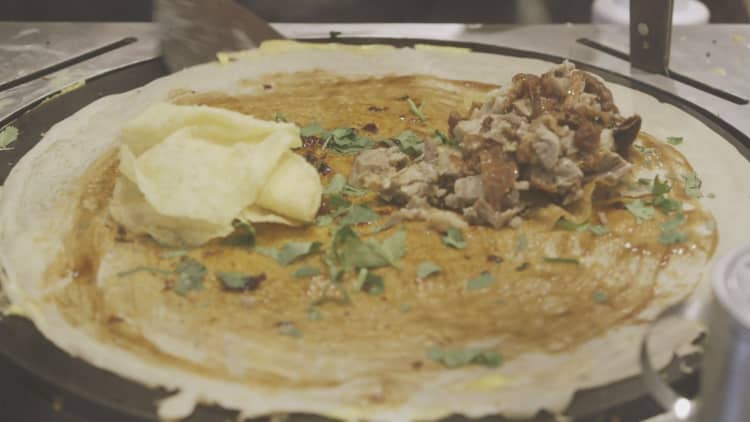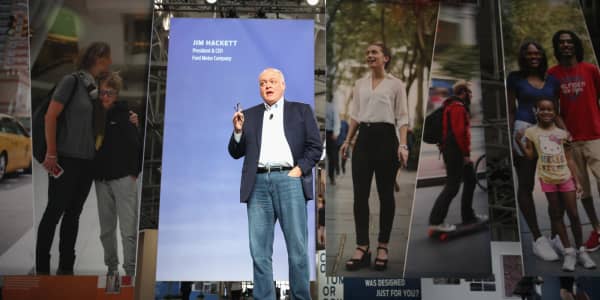
Specialty Asian foods are hot. Poke bowls, raw
There's also a trendy street food making waves in New York City that goes by many borrowed names as locals try to wrap their tongues around it. Is it a Chinese burrito? A Chinese Dosa? The New York Times has weighed in — twice — this year on the topic.
"People call it different things. But we really want to teach people it's a
Call it the Bing Mac attack if you want — a Chinese answer to McDonald's all-day breakfast — the
Goldberg has a long history with the traditional Chinese snack. He first discovered the
And that's how I got into it," he said.
People call it different things. But we really want to teach people it's a bing.Brian Goldbergfounder of Mr. Bing
When he came back to the United States, Goldberg realized how much missed it. Later, when he took business courses during graduate school at Columbia University, Goldberg created a business plan for a
"Just to learn about discounted cash flow and how to put a business plan together. ... It was called Goldberg Chinese Crepes at the time [2001]. I mean, I got an A minus on the report."
The crepe, which is very common in Shandong, Tianjin, Beijing and Shanghai, is becoming more familiar to trendy eaters at the Urbanspace Vanderbilt upscale food hall near Grand Central Terminal in New York City, where Mr. Bing landed its biggest deal. It's the first food property developed by Urbanspace, which grew out of Urban Space Management, a U.K. firm that since 1970 has more than 50 projects that revamp derelict city spaces and old properties.
"They loved it, and they said, 'Can you make one for us tomorrow?' ... I went to Chinatown, bought some ingredients, got a crepe machine, made it for them in their office, and they loved it. ... And they offered me a spot," Goldberg said. "I had seven days to get ready. I had to incorporate a company."
More from iCONIC
The 10 best food trucks in America
Newman's Own on feel-good quest for $1 billion in sales
Meet America's mad scientist brewers
In November 2015, Mr. Bing had a tryout at one of the outdoor holiday markets in New York City that Urban Space runs in the winter. Mr. Bing then spent a year doing pop-ups and catering, what Goldberg called a year of building the
Goldberg said in the restaurant business an owner has to aim for $1 million a year in revenue and 20 percent on the bottom line per unit. Mr. Bing recently received an SBA loan to help fund its expansion.
"We can create a scalable hub-and-spoke model that can be replicated in different cities," Goldberg said. "Once you achieve a critical mass of locations in a particular city, you can replicate that. ... It becomes very small square footage that you need. It's a relatively small investment. ... It's a cash generator ... and it becomes something you can really scale, creates jobs and gives opportunities to other entrepreneurs."
He said several food-business trends are reflected in the Mr. Bing success story, especially aspects of the fast-casual cuisine boom. People like food that is fresh and made right in front of them. Food halls are becoming more popular because they create a sense of community and elevate the standard mall food-court experience. From an economic perspective, the food hall makes sense for businesses, since it is a common facility.
Goldberg, who has a bit of a restless history — in addition to grad school, he got accepted to medical school (turned it down), worked as a TV reporter and as an Olympic luger — says it was about four years ago that he started getting the entrepreneurial bug. Leaving one thing behind and trying something new was "not like out of whack with my history," Goldberg said. "When I latch on to an idea that I get really passionate about, I eventually go ahead and do it to the best of my ability. ... Mr. Bing is just another incarnation of that, of my sort of style."
He had been working for about a decade in equity sales trading in Hong Kong and Taiwan for local banks.
"When you are in finance, it's fantastic. You
Bada bing
He read the Howard Schultz book about Starbucks and the Ray Kroc book about McDonald's and decided that the time had come for that old business plan from Columbia, even if it needed a new name. "I just wanted to make something to just sort of change the world a little bit. I wanted to take one of my experiences after all those years in Asia and bring it back to America, to the Western world, and basically leave some kind of mark, like a physical product, a brand," Goldberg said.
He noticed a lot of people on the internet talking about bringing the
"I had some money put away, and I knew that if it didn't work out, I could probably always go back to finance or something else, and I just I had a lot of momentum, and I was really caught up in the excitement of doing this."
Goldberg said franchise requests have come in from places as far apart as South Africa, Dubai, London, South Korea and the Philippines.
"We have definitely created a brand and a food on a concept that has legs," he said. After initial success — but ultimate failure — with his first version of Mr. Bing in Hong Kong, Goldberg said it started becoming more apparent that the U.S. market might be the healthier environment for the business plan. "More unique. More on trend. Bigger market to expand," he said. "I think there's a long road ahead of me to build Mr.Bing to become what I hope it becomes. It's very exciting seeing Americans eat this food. They have never had it, but they really like it — the layers, the textures and colors and the history behind it."
Goldberg said he does not miss the more stable income flow of the financial industry, but there's a little of the high-pressure, high-speed trader still in him.
"We keep setting the benchmark higher to what you can do every day. How many bings you can make in a minute, 10 minutes or in a day. One of our big challenges going forward is how to make things faster at the rush."
— Video by Qin Chen and Mackenzie Sigalos




